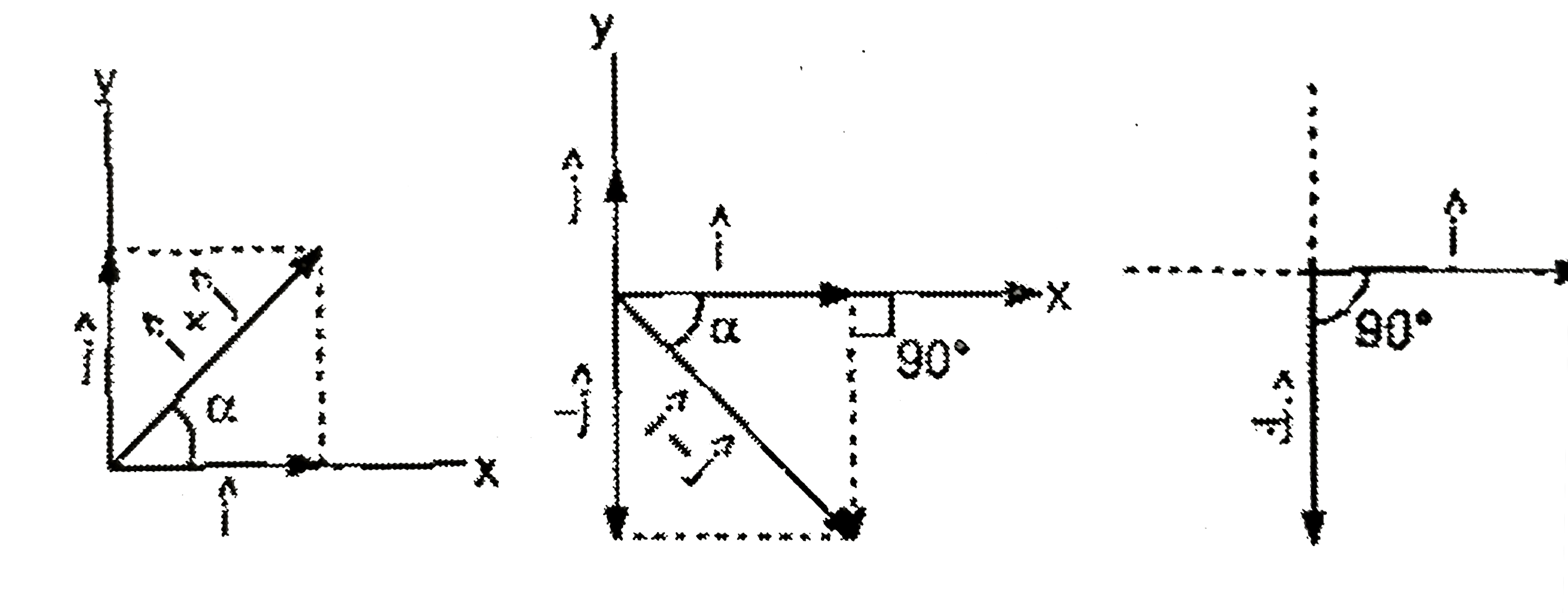Two vectors →pand→q lie in the xy plane. Their magnitudes are 3.50and6.30 units, repspectively, and their directions are 220∘and75.0∘, respectively, as measured countercloskwise from the positive x axis. What are the values of (a)→p×→q(b)→p.→q ?
To solve the problem, we need to calculate the cross product and dot product of the two vectors →p and →q given their magnitudes and directions.
Given Data:
- Magnitude of →p=3.50 units
- Direction of →p=220∘ (measured counterclockwise from the positive x-axis)
- Magnitude of →q=6.30 units
- Direction of →q=75.0∘ (measured counterclockwise from the positive x-axis)
Step 1: Convert Vectors to Component Form
We can express the vectors in terms of their components using trigonometric functions.
For →p:
→p=|→p|⋅(cos(220∘)^i+sin(220∘)^j)
Calculating the components:
cos(220∘)=−cos(40∘)≈−0.766andsin(220∘)=−sin(40∘)≈−0.643
Thus,
→p≈3.50⋅(−0.766^i−0.643^j)≈−2.68^i−2.25^j
For →q:
→q=|→q|⋅(cos(75∘)^i+sin(75∘)^j)
Calculating the components:
cos(75∘)≈0.2588andsin(75∘)≈0.9659
Thus,
→q≈6.30⋅(0.2588^i+0.9659^j)≈1.63^i+6.09^j
Step 2: Calculate the Cross Product →p×→q
The cross product of two vectors in the xy-plane can be calculated using the determinant of a matrix:
→p×→q=∣∣
∣
∣∣^i^j^k−2.68−2.2501.636.090∣∣
∣
∣∣
Calculating the determinant:
→p×→q=^k((−2.68)(6.09)−(−2.25)(1.63))
Calculating the values:
=^k(−16.3052+3.67375)=^k(−12.63145)
Thus,
→p×→q≈−12.63^k
Step 3: Calculate the Dot Product →p⋅→q
The dot product is given by:
→p⋅→q=|→p||→q|cos(θ)
Where θ is the angle between the two vectors. The angle θ can be calculated as:
θ=220∘−75∘=145∘
Now, calculating the dot product:
→p⋅→q=(3.50)(6.30)cos(145∘)
Calculating cos(145∘):
cos(145∘)≈−0.819
Thus,
→p⋅→q=3.50⋅6.30⋅(−0.819)≈−18.1
Final Answers:
(a) →p×→q≈−12.63^k
(b) →p⋅→q≈−18.1
- Magnitude of →p=3.50 units
- Direction of →p=220∘ (measured counterclockwise from the positive x-axis)
- Magnitude of →q=6.30 units
- Direction of →q=75.0∘ (measured counterclockwise from the positive x-axis)
We can express the vectors in terms of their components using trigonometric functions.
→p=|→p|⋅(cos(220∘)^i+sin(220∘)^j)
Calculating the components:
cos(220∘)=−cos(40∘)≈−0.766andsin(220∘)=−sin(40∘)≈−0.643
Thus,
→p≈3.50⋅(−0.766^i−0.643^j)≈−2.68^i−2.25^j
→q=|→q|⋅(cos(75∘)^i+sin(75∘)^j)
Calculating the components:
cos(75∘)≈0.2588andsin(75∘)≈0.9659
Thus,
→q≈6.30⋅(0.2588^i+0.9659^j)≈1.63^i+6.09^j
The cross product of two vectors in the xy-plane can be calculated using the determinant of a matrix:
→p×→q=∣∣
∣
∣∣^i^j^k−2.68−2.2501.636.090∣∣
∣
∣∣
Calculating the determinant:
→p×→q=^k((−2.68)(6.09)−(−2.25)(1.63))
Calculating the values:
=^k(−16.3052+3.67375)=^k(−12.63145)
Thus,
→p×→q≈−12.63^k
The dot product is given by:
→p⋅→q=|→p||→q|cos(θ)
Where θ is the angle between the two vectors. The angle θ can be calculated as:
θ=220∘−75∘=145∘
Now, calculating the dot product:
→p⋅→q=(3.50)(6.30)cos(145∘)
Calculating cos(145∘):
cos(145∘)≈−0.819
Thus,
→p⋅→q=3.50⋅6.30⋅(−0.819)≈−18.1
(a) →p×→q≈−12.63^k
(b) →p⋅→q≈−18.1
Topper's Solved these Questions
- BOOK - RESNICK AND HALLIDAYCHAPTER - VECTORS EXERCISE - PRACTICE QUESTIONS39videos
VECTORS
- BOOK - RESNICK AND HALLIDAYCHAPTER - VECTORS EXERCISE - CHECKPOINT5videos
VECTORS
- BOOK - RESNICK AND HALLIDAYCHAPTER - UNITS AND MEASUREMENT EXERCISE - PRACTICE QUESTIONS (MATRIX-MATCH)11videos
UNITS AND MEASUREMENT
- BOOK - RESNICK AND HALLIDAYCHAPTER - WAVE - IIEXERCISE - PRACTICE QUESTIONS (INTEGER TYPE)5videos
WAVE - II
Similar Questions
vector →a lies in the xy plane, has a magnitude of 18 units, and points in a direction 250∘ from the positive direction of the x axis. Also, vector →b has a magnitude of 12 units and points in the positive direction of the z axis. What is the vector product →c=→a×→b ?
View SolutionThere vectors →a,→b and →c each have a magnitude of 50 m and lie in an xy plane. Their directions relative to the positive direction of the x axis are 30∘,195∘,and315∘, respectively. What are (a) the magnitude and (b) the angle of the vector →a+→b+→c, and (c ) the magnitude and (d) the angle of →a−→b−→c ? What are the (e) magnitude and (f) angle of a fourth vector →d such that (→a+→b)−(→c+→d)=0 ?
View Solution
Knowledge Check
- Question 1 - Select One
If →P−→Q−→R=0 and the magnitudes of →P,→Qand→R are 5 , 4 and 3 units respectively, the angle between →Pand→R is
Acos−1(35)Bcos−1(45)Cπ2Dsin−1(34) - Question 2 - Select One or More
Two vectors →Pand→Q lie one plane. Vectors →R lies in a differenct plane. In such a case, →P+→Q+→R
Acan be zeroBcannot be zeroClies in the sama plane as →P or →QDlies in the plane different from that of any two of 3 vectors - Question 3 - Select One
If vectors →P,→Qand→R have magnitudes 5, 12 and 13 units and →P+→Q=→R, the angle between →Qand→R is :
Acos−1(512)Bcos−1(513)Ccos−1(1213)Dcos−1(213)
Find the angle between two vectors →p and →q are 4,3 with respectively and when →p.→q=5.
View SolutionTwo unit vectors ˆi and ˆj are directed along x-axis and y-axis respectively. What is the magnitude and direction of the vectors ˆi+ˆjandˆi−ˆj?
 View Solution
View SolutionIf vectors →P,→Qand→R have magnitudes 5, 12 and 13 units and →P+→Q=→R, the angle between →Qand→R is :
View SolutionIf vectors →P,→Qand→R have magnitudes 5, 12 and 13 units and →P+→Q=→R, the angle between →Qand→R is :
View SolutionA vector a makes 30∘ and b makes 120∘ angle with the x-axis. The magnitude of these vectors are 3 unit and 4 unit, respectively. The magnitude of resultant vector is
View Solution

